spare wheel FIAT SCUDO 2012 Owner handbook (in English)
[x] Cancel search | Manufacturer: FIAT, Model Year: 2012, Model line: SCUDO, Model: FIAT SCUDO 2012Pages: 219, PDF Size: 4.13 MB
Page 139 of 219
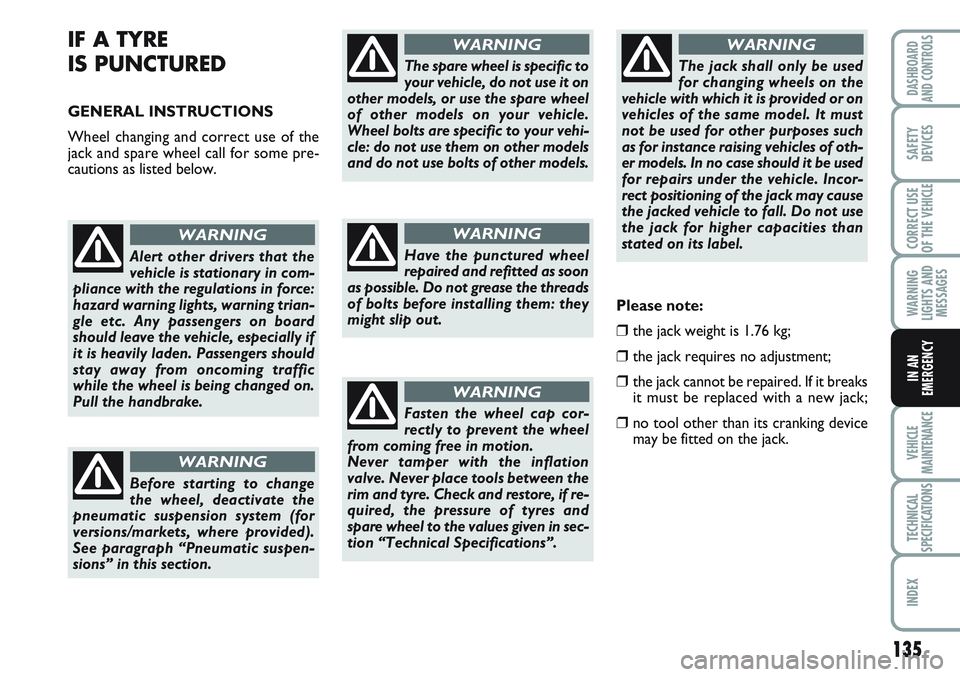
135
WARNING
LIGHTS AND
MESSAGES
VEHICLE
MAINTENANCE
TECHNICAL
SPECIFICATIONS
INDEX
DASHBOARD
AND CONTROLS
SAFETY
DEVICES
CORRECT USE
OF THE
VEHICLE
IN AN
EMERGENCY
IF A TYRE
IS PUNCTURED
GENERAL INSTRUCTIONS
Wheel changing and correct use of the
jack and spare wheel call for some pre-
cautions as listed below.
Alert other drivers that the
vehicle is stationary in com-
pliance with the regulations in force:
hazard warning lights, warning trian-
gle etc. Any passengers on board
should leave the vehicle, especially if
it is heavily laden. Passengers should
stay away from oncoming traffic
while the wheel is being changed on.
Pull the handbrake.
WARNING
Before starting to change
the wheel, deactivate the
pneumatic suspension system (for
versions/markets, where provided).
See paragraph “Pneumatic suspen-
sions” in this section.
WARNING
The spare wheel is specific to
your vehicle, do not use it on
other models, or use the spare wheel
of other models on your vehicle.
Wheel bolts are specific to your vehi-
cle: do not use them on other models
and do not use bolts of other models.
WARNING
Have the punctured wheel
repaired and refitted as soon
as possible. Do not grease the threads
of bolts before installing them: they
might slip out.
WARNING
The jack shall only be used
for changing wheels on the
vehicle with which it is provided or on
vehicles of the same model. It must
not be used for other purposes such
as for instance raising vehicles of oth-
er models. In no case should it be used
for repairs under the vehicle. Incor-
rect positioning of the jack may cause
the jacked vehicle to fall. Do not use
the jack for higher capacities than
stated on its label.
WARNING
Fasten the wheel cap cor-
rectly to prevent the wheel
from coming free in motion.
Never tamper with the inflation
valve. Never place tools between the
rim and tyre. Check and restore, if re-
quired, the pressure of tyres and
spare wheel to the values given in sec-
tion “Technical Specifications”.
WARNING
Please note:
❒ the jack weight is 1.76 kg;
❒ the jack requires no adjustment;
❒ the jack cannot be repaired. If it breaks
it must be replaced with a new jack;
❒ no tool other than its cranking device
may be fitted on the jack.
Page 140 of 219
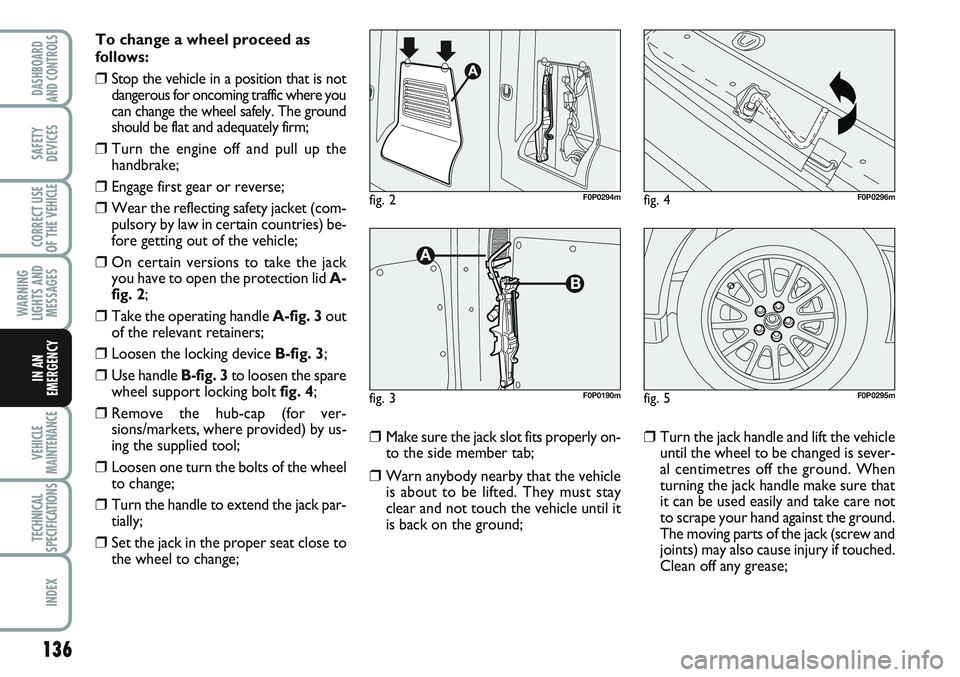
136
WARNING
LIGHTS AND
MESSAGES
VEHICLE
MAINTENANCE
TECHNICAL
SPECIFICATIONS
INDEX
DASHBOARD
AND CONTROLS
SAFETY
DEVICES
CORRECT USE
OF THE
VEHICLE
IN AN
EMERGENCY
To change a wheel proceed as
follows:
❒Stop the vehicle in a position that is not
dangerous for oncoming traffic where you
can change the wheel safely. The ground
should be flat and adequately firm;
❒ Turn the engine off and pull up the
handbrake;
❒Engage first gear or reverse;
❒Wear the reflecting safety jacket (com-
pulsory by law in certain countries) be-
fore getting out of the vehicle;
❒On certain versions to take the jack
you have to open the protection lid A-
fig. 2;
❒Take the operating handle A-fig. 3 out
of the relevant retainers;
❒Loosen the locking device B-fig. 3;
❒Use handle B-fig. 3to loosen the spare
wheel support locking bolt fig. 4;
❒Remove the hub-cap (for ver-
sions/markets, where provided) by us-
ing the supplied tool;
❒Loosen one turn the bolts of the wheel
to change;
❒Turn the handle to extend the jack par-
tially;
❒Set the jack in the proper seat close to
the wheel to change;
❒Make sure the jack slot fits properly on-
to the side member tab;
❒Warn anybody nearby that the vehicle
is about to be lifted. They must stay
clear and not touch the vehicle until it
is back on the ground;
❒Turn the jack handle and lift the vehicle
until the wheel to be changed is sever-
al centimetres off the ground. When
turning the jack handle make sure that
it can be used easily and take care not
to scrape your hand against the ground.
The moving parts of the jack (screw and
joints) may also cause injury if touched.
Clean off any grease;
fig. 4F0P0296m
fig. 5F0P0295m
fig. 2F0P0294m
fig. 3F0P0190m
Page 141 of 219
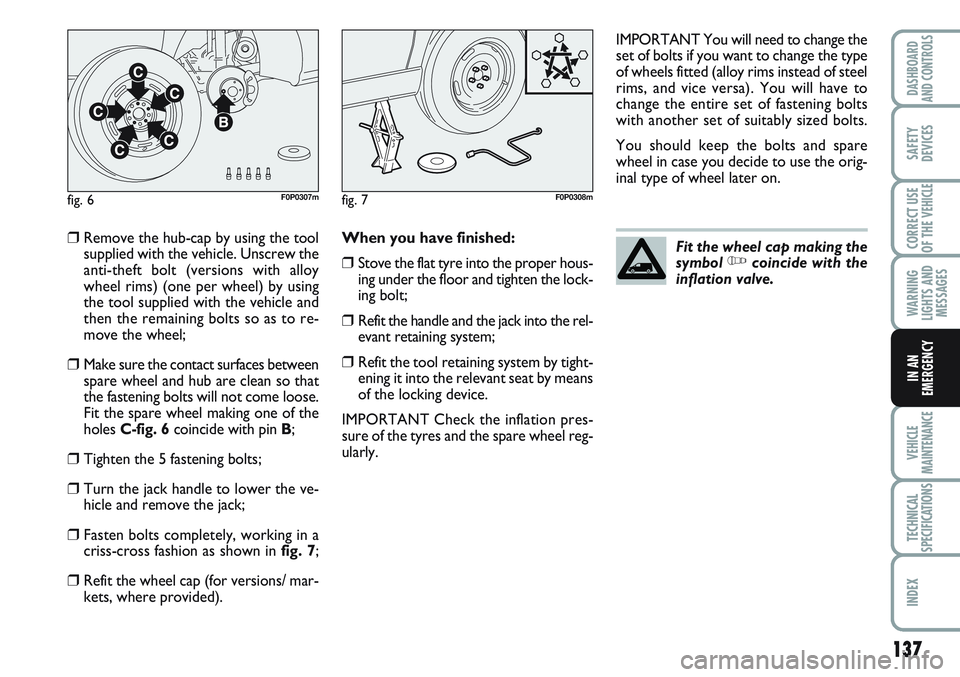
137
WARNING
LIGHTS AND
MESSAGES
VEHICLE
MAINTENANCE
TECHNICAL
SPECIFICATIONS
INDEX
DASHBOARD
AND CONTROLS
SAFETY
DEVICES
CORRECT USE
OF THE
VEHICLE
IN AN
EMERGENCY
❒Remove the hub-cap by using the tool
supplied with the vehicle. Unscrew the
anti-theft bolt (versions with alloy
wheel rims) (one per wheel) by using
the tool supplied with the vehicle and
then the remaining bolts so as to re-
move the wheel;
❒Make sure the contact surfaces between
spare wheel and hub are clean so that
the fastening bolts will not come loose.
Fit the spare wheel making one of the
holes C-fig. 6coincide with pin B;
❒Tighten the 5 fastening bolts;
❒Turn the jack handle to lower the ve-
hicle and remove the jack;
❒Fasten bolts completely, working in a
criss-cross fashion as shown in fig. 7;
❒Refit the wheel cap (for versions/ mar-
kets, where provided).When you have finished:
❒Stove the flat tyre into the proper hous-
ing under the floor and tighten the lock-
ing bolt;
❒Refit the handle and the jack into the rel-
evant retaining system;
❒Refit the tool retaining system by tight-
ening it into the relevant seat by means
of the locking device.
IMPORTANT Check the inflation pres-
sure of the tyres and the spare wheel reg-
ularly.IMPORTANT You will need to change the
set of bolts if you want to change the type
of wheels fitted (alloy rims instead of steel
rims, and vice versa). You will have to
change the entire set of fastening bolts
with another set of suitably sized bolts.
You should keep the bolts and spare
wheel in case you decide to use the orig-
inal type of wheel later on.
fig. 6F0P0307mfig. 7F0P0308m
Fit the wheel cap making the
symbol Ycoincide with the
inflation valve.
Page 171 of 219
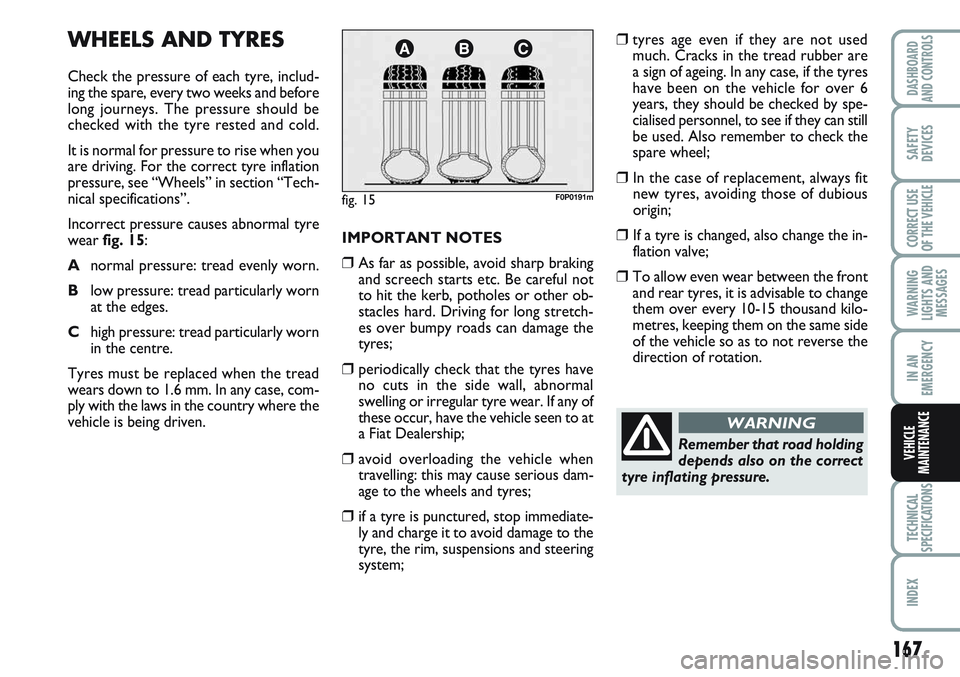
167
WARNING
LIGHTS AND
MESSAGES
TECHNICAL
SPECIFICATIONS
INDEX
DASHBOARD
AND CONTROLS
SAFETY
DEVICES
CORRECT USE
OF THE
VEHICLE
IN AN
EMERGENCY
VEHICLE
MAINTENANCE
WHEELS AND TYRES
Check the pressure of each tyre, includ-
ing the spare, every two weeks and before
long journeys. The pressure should be
checked with the tyre rested and cold.
It is normal for pressure to rise when you
are driving. For the correct tyre inflation
pressure, see “Wheels” in section “Tech-
nical specifications”.
Incorrect pressure causes abnormal tyre
wearfig. 15:
Anormal pressure: tread evenly worn.
Blow pressure: tread particularly worn
at the edges.
Chigh pressure: tread particularly worn
in the centre.
Tyres must be replaced when the tread
wears down to 1.6 mm. In any case, com-
ply with the laws in the country where the
vehicle is being driven.
fig. 15F0P0191m
IMPORTANT NOTES
❒As far as possible, avoid sharp braking
and screech starts etc. Be careful not
to hit the kerb, potholes or other ob-
stacles hard. Driving for long stretch-
es over bumpy roads can damage the
tyres;
❒periodically check that the tyres have
no cuts in the side wall, abnormal
swelling or irregular tyre wear. If any of
these occur, have the vehicle seen to at
a Fiat Dealership;
❒avoid overloading the vehicle when
travelling: this may cause serious dam-
age to the wheels and tyres;
❒if a tyre is punctured, stop immediate-
ly and charge it to avoid damage to the
tyre, the rim, suspensions and steering
system;
❒tyres age even if they are not used
much. Cracks in the tread rubber are
a sign of ageing. In any case, if the tyres
have been on the vehicle for over 6
years, they should be checked by spe-
cialised personnel, to see if they can still
be used. Also remember to check the
spare wheel;
❒ In the case of replacement, always fit
new tyres, avoiding those of dubious
origin;
❒ If a tyre is changed, also change the in-
flation valve;
❒To allow even wear between the front
and rear tyres, it is advisable to change
them over every 10-15 thousand kilo-
metres, keeping them on the same side
of the vehicle so as to not reverse the
direction of rotation.
Remember that road holding
depends also on the correct
tyre inflating pressure.
WARNING
Page 187 of 219
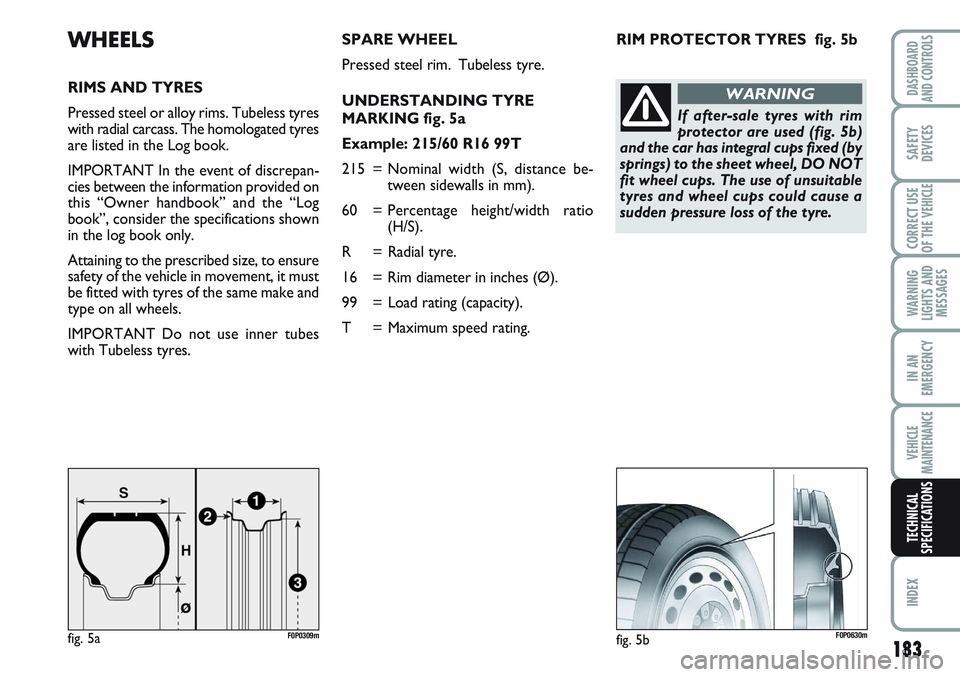
RIM PROTECTOR TYRES fig. 5bWHEELS
RIMS AND TYRES
Pressed steel or alloy rims. Tubeless tyres
with radial carcass. The homologated tyres
are listed in the Log book.
IMPORTANT In the event of discrepan-
cies between the information provided on
this “Owner handbook” and the “Log
book”, consider the specifications shown
in the log book only.
Attaining to the prescribed size, to ensure
safety of the vehicle in movement, it must
be fitted with tyres of the same make and
type on all wheels.
IMPORTANT Do not use inner tubes
with Tubeless tyres.
fig. 5aF0P0309m
SPARE WHEEL
Pressed steel rim. Tubeless tyre.
UNDERSTANDING TYRE
MARKING fig. 5a
Example: 215/60 R16 99T
215 = Nominal width (S, distance be-
tween sidewalls in mm).
60 = Percentage height/width ratio
(H/S).
R = Radial tyre.
16 = Rim diameter in inches (Ø).
99 = Load rating (capacity).
T = Maximum speed rating.
fig. 5bF0P0630m
If after-sale tyres with rim
protector are used (fig. 5b)
and the car has integral cups fixed (by
springs) to the sheet wheel, DO NOT
fit wheel cups. The use of unsuitable
tyres and wheel cups could cause a
sudden pressure loss of the tyre.
WARNING
VEHICLE
MAINTENANCE
IN AN
EMERGENCY
CORRECT USE
OF THE
VEHICLE
SAFETY
DEVICES
DASHBOARD
AND CONTROLS
INDEX
WARNING
LIGHTS AND
MESSAGES
183
TECHNICAL
SPECIFICATIONS